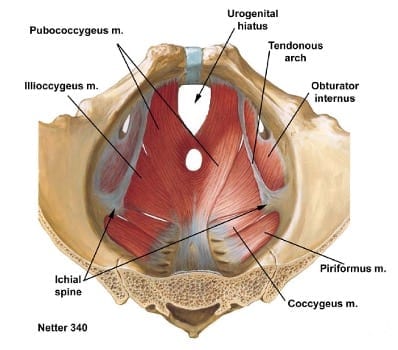When you are running, walking or just doing other daily movements, the pelvic floor plays a major yet often silent role.
What is the pelvic floor?

The pelvic floor consists of muscles at the bottom of your pelvis that help hold up your bladder and close off the bottom of your abdominal cavity. The abdominal cavity is like a can: it is closed on top by your diaphragm, in back by your spine and back muscles and in front by your abdominal muscles. These pelvic floor muscles are unique in that they should be able to relax and stretch down as well as lift for contraction, almost like a trampoline. This ability to contract and relax is important in understanding what dysfunction is and how it can be problematic. The pelvic floor also closes off the urethra, helping hold urine in.
Urinary incontinence
The ability to hold and control urine release is called continence, so therefore, inability to hold urine is called urinary incontinence. When doing motions such as running, walking or other functional actions, many women experience urinary incontinence—more specifically called stress incontinence—which typically occurs due to dysfunction of the pelvic floor or inappropriate pressure build up in abdominal cavity. Pelvic floor dysfunction in women is commonly caused by childbirth, menopause, and obesity. Dysfunction is most easily explained as the pelvic floor not listening and responding correctly to the brain or other body pressures. This dysfunction is important to understand when considering all the motions and muscles required for running.
Running and pelvic dysfunction

One in three women over 30 experience urinary incontinence while running. When you run, you are activating many muscles and absorbing many forces. This image to the right shows some of the different muscles that are important for running, and as you will notice, all of them attach at the pelvis. This means that they are neighbors to the pelvic floor and will affect the actions of the pelvic floor muscles. From the picture you can see that these muscles use forces larger than your body weight to move. These muscles are also absorbing a ground reaction force each time your foot strikes the ground. Forces are then sent through multiple bones and muscle and eventually will reach the pelvis to be absorbed as well. All these things are important to understand when it comes to stress urinary incontinence, which is experienced by many female runners—and occasionally males , typically after prostate cancer. If your pelvic floor is weak, it can be hard for it to contract consistently to hold the urine and do its job holding the bladder in place.
Muscles, ligaments and pelvic health
In addition to weakness, pelvic floor dysfunction will also play a role. Dysfunction also relates not only to muscles, but all the ligaments and connective tissues that play a role in supporting the pelvis and organs. Some possible reasons for this dysfunction during running can be from the muscles not functioning correctly, or other muscles overcompensating; an example could be the abdominal muscles bracing too much and not allowing the pelvic floor to absorb those ground reaction forces the way they are meant to. The muscles of the pelvic floor could also be too tight and not able to absorb or dissipate those big forces in correctly, also leading to incontinence. Breathing and pressure build-up is also important in understanding dysfunction because too much or too little pressure will cause the muscles to function incorrectly as well. For instance, holding in your breath will increase the abdominal pressure or shallow breathing can leave too little pressure, as well making the system very unbalanced. The good thing about this explanation is that you are not alone: There are ways to help correct this and now that you understand a bit more of why this is occurring you can work on fixing it.
How to increase pelvic floor strength
Some ways to improve a weak pelvic floor are exercises like breathing awareness during the activity; doing a pelvic floor contraction before, and working on specifically coordinating the pelvic floor muscles to contract correctly and on time. When breathing in deeply, use your diaphragm and focus on allowing the pelvic floor to drop a bit; your stomach should protrude outward. When breathing out, as your diaphragm comes up, your abdominals should come in, as should your pelvic floor; remember, the “can” should move together. This breathing pattern is important for keeping pressure normalized, as well as putting less pressure on the bladder. The best way to work on bracing before lifting: contract the pelvic floor like you’re breathing all the air out of your lungs, but actively contract by pulling the pelvic floor up a little bit before you begin your lift.
These resources and strategies can help treat stress incontinence, but you don’t have to do it alone. Our exceptional physical therapists are experts in pelvic health and can create a strengthening program specifically for your activities and goals. For more information, visit the Des Moines University Physical Therapy Clinic website or call 515-271-1717.


